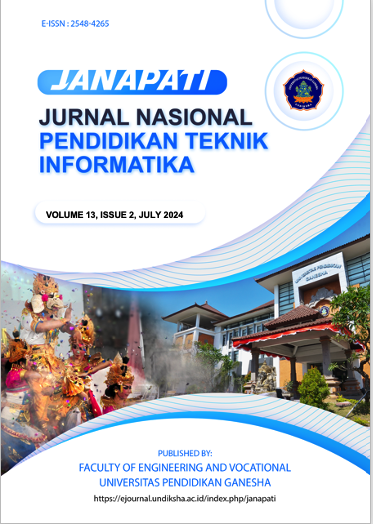IoT-Based Humidity Control System for Electrospinning
DOI:
https://doi.org/10.23887/janapati.v13i2.75896Keywords:
Electrospinning, Humidity, Humidity Control System, IoT, DHT22, BlynkAbstract
In recent years, electrospinning has become the most common and most widely used nanofiber manufacturing method. One parameter affecting the manufacturing process is the humidity parameter, which affects the morphology. The control tools that have been developed have not been equipped with a remote control and monitoring system. This research aims to develop a humidity control system that can be controlled and monitored remotely and is equipped with data recapitulation. This research used methods from literature studies on humidity control systems, manufacture and assembly of hardware and software, calibration, and performance tests. A humidity control device is produced using a NodeMCU microcontroller connected to the IoT-based Blynk application. This can be controlled and monitored manually with an LCD and Keypad or by using a handphone through the Blynk application, and the humidity value can be recapitulated with Google Sheets in real-time. The sensor used for reading this humidity value is a DHT 22 sensor which has an accuracy value of 99.72% and a precision of 98.81% for 45%-95% humidity. This IoT-based humidity control system device can automate the process of controlling, monitoring, and recapitulating humidity data in real-time.
References
A. Nadaf et al., “Recent update on electrospinning and electrospun nanofibers: current trends and their applications,” RSC Adv., vol. 12, no. 37, pp. 23808–23828, 2022, doi: 10.1039/d2ra02864f.
M. Zhang, W. Song, Y. Tang, X. Xu, Y. Huang, and D. Yu, “Polymer-Based Nanofiber–Nanoparticle Hybrids and Their Medical Applications,” Polymers (Basel)., vol. 14, no. 2, 2022, doi: 10.3390/polym14020351.
K. Abidin, J. D. Malago, F. A. Noor, and T. Winata, “Pengaruh Massa Source Terhadap Ketebalan Thin Film Melalui Deposisi Vacuum Thermal Evaporation,” JFT J. Fis. dan Ter., vol. 8, no. 1, p. 1, 2021, doi: 10.24252/jft.v8i1.21350.
S. Vempati, K. S. Ranjith, F. Topuz, N. Biyikli, and T. Uyar, “Electrospinning Combined with Atomic Layer Deposition to Generate Applied Nanomaterials: A Review,” ACS Appl. Nano Mater., vol. 3, no. 7, pp. 6186–6209, 2020, doi: 10.1021/acsanm.0c01120.
A. Al-abduljabbar and I. Farooq, “Electrospun Polymer Nanofibers: Processing, Properties, and Applications,” 2023.
A. Keirouz et al., “The History of Electrospinning: Past, Present, and Future Developments,” Adv. Mater. Technol., vol. 8, no. 11, pp. 1–34, 2023, doi: 10.1002/admt.202201723.
A. Raksa, P. O. Numpaisal, and Y. Ruksakulpiwat, “The effect of humidity during electrospinning on morphology and mechanical properties of SF/PVA nanofibers,” Mater. Today Proc., vol. 47, pp. 3458–3461, 2021, doi: 10.1016/j.matpr.2021.03.459.
S. De Vrieze, T. Van Camp, A. Nelvig, B. Hagström, P. Westbroek, and K. De Clerck, “The effect of temperature and humidity on electrospinning,” J. Mater. Sci., vol. 44, no. 5, pp. 1357–1362, 2009, doi: 10.1007/s10853-008-3010-6.
B. Bessaire et al., “Synthesis of continuous conductive PEDOT: PSS nanofibers by electrospinning: A conformal coating for optoelectronics,” ACS Appl. Mater. Interfaces, vol. 9, no. 1, pp. 950–957, 2017, doi: 10.1021/acsami.6b13453.
J. Pelipenko, J. Kristl, B. Janković, S. Baumgartner, and P. Kocbek, “The impact of relative humidity during electrospinning on the morphology and mechanical properties of nanofibers.,” Int. J. Pharm., vol. 456, no. 1, pp. 125–134, 2013, doi: 10.1016/j.ijpharm.2013.07.078.
D. Anggoro, M. R. Romadhoni, I. Muhlas, and I. Fatimah, “The Influence of Humidity-Control Addition on Electrospinning System for Nanofiber Formation,” J. Fis. dan Apl., vol. 18, no. 1, p. 10, 2022, doi: 10.12962/j24604682.v18i1.11659.
D. Shintawati & Ermaya, “VALIDASI METODE PENGUJIAN KADAR AIR DENGAN ANALISIS PERBANDINGAN AKURASI DAN PRESISI,” SJAT Serambi J. Agric. Technol., vol. 5, no. 1, pp. 59–63, 2023, [Online]. Available: https://pdfs.semanticscholar.org/3cc1/74525db9336469af32aa2165494b0fba76b6.pdf.
W. I. P. A. Wahyu, I. N. P. A. Widyanata, Prastya I Wayan Wahyu Adi, Darminta I Ketut, Sangka I Gde Nyoman, and Sapteka Anak Agung Ngurah Gde, “Perbandingan Kinerja Arduino Uno dan ESP32 Terhadap,” J. Otomasi, Kontrol Instrumentasi, vol. 13 (1), no. 1, pp. 37–45, 2021.
M. E. Putra et al., “Akurasi Dan Presisi Alat Ukur Tinggi Badan Digital Untuk Penilaian Status Gizi,” J. Endur., vol. 6, no. 3, pp. 616–621, 2022, doi: 10.22216/jen.v6i3.580.
D. Koutsandreas, E. Spiliotis, F. Petropoulos, and V. Assimakopoulos, “On the selection of forecasting accuracy measures,” J. Oper. Res. Soc., vol. 73, no. 5, pp. 937–954, 2022, doi: 10.1080/01605682.2021.1892464.
J. E. M. Perea Martins, “Introducing the concepts of measurement accuracy and precision in the classroom,” Phys. Educ., vol. 54, no. 5, 2019, doi: 10.1088/1361-6552/ab3143.
S. Widyaningrum, Purwanto, Y. A., & Mardjan, “Desain Sistem Kontrol dan Monitoring Kondisi Udara pada Controlled Atmosphere Storage Berbasis Mikrokontroler Arduino Uno.,” J. Keteknikan Pertan., vol. 6, no. 1, pp. 75–82, 2019.
M. A. Asis, P. Purnawansyah, and A. R. Manga, “Penerapan System Development Life Cycle pada Sistem Validasi Metode Analisis Sediaan Farmasi,” Bul. Sist. Inf. dan Teknol. Islam, vol. 1, no. 3, pp. 145–149, 2020, doi: 10.33096/busiti.v1i3.883.
Soewarno, Aplikasi Metode Statistika untuk Analisis Data Hidrologi. Graha Ilmu, 2014.
Downloads
Published
How to Cite
Issue
Section
License
Copyright (c) 2024 Luluk Arifatul Hikamiah, Dewa Pascal Ariyanto, Della Astri Widayani, Panji Setyo Nugroho, Jasmine Cupid Amaratirta, Dewanto Harjunowibowo, Yulianto Agung Rezeki

This work is licensed under a Creative Commons Attribution-ShareAlike 4.0 International License.
Authors who publish with Janapati agree to the following terms:- Authors retain copyright and grant the journal the right of first publication with the work simultaneously licensed under a Creative Commons Attribution License (CC BY-SA 4.0) that allows others to share the work with an acknowledgment of the work's authorship and initial publication in this journal
- Authors are able to enter into separate, additional contractual arrangements for the non-exclusive distribution of the journal's published version of the work (e.g., post it to an institutional repository or publish it in a book), with an acknowledgment of its initial publication in this journal.
- Authors are permitted and encouraged to post their work online (e.g., in institutional repositories or on their website) prior to and during the submission process, as it can lead to productive exchanges, as well as earlier and greater citation of published work. (See The Effect of Open Access)







